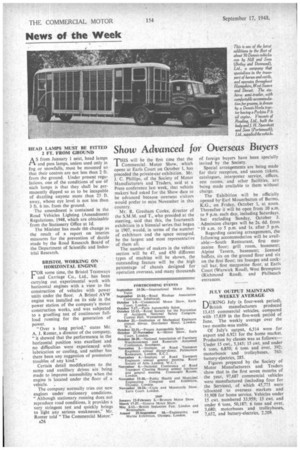News of the Week
Page 28

If you've noticed an error in this article please click here to report it so we can fix it.
HEAD LAMPS MUST BE FITTED 2 FT. FROM GROUND
A S from January 1 next, head lamps
and pass lamps, unless used only in fog or snowfalls, must be mounted so that their centres are not less than 2 ft. from the ground. Under present regulations, one of the conditions of use Of such lamps is that they shall be permanently dipped so as to be incapable of dazzling anyone more than 25 ft. away, whose eye level is not less than 3 ft. 6 ins. from theground.
The amendment is contained in the Road Vehicles Lighting (Amendment) Regulations, 1948, which are obtainable from the Stationery Office at Id, The Minister has made tht change as the result of a report on interim measures for the prevention of dazzle made by the Road Research Board of the Department of Scientific and Industrial Research, BRISTOL WORKING ON HORIZONTAL ENGINE VOR some time, the Bristol Tramways and Carriage Co., Ltd., has been carrying out experimental work with horizontal engines with a view to the construction of vehicles with power units under the floor. A Bristol AVW engine was installed on its side in the power station of the company's motor construction works, and was subjected to a gruelling test of continuous fullload running for the generation of power. Over a long period." states Mr. A. J. Romer, a director of the company, "it showed that the performance in the horizontal position was excellent and no difficulties were experienced with lubrication or cooling, and neither has there been any suggestion of premature troubles of any kind."
Certain detail modifications to the sump and auxiliary drives are being made to improve accessibility when the engine is located under the floor of a vehicle. , The company normally tries out new engines under stationary conditions. "Although stationary running does not reproduce road conditions, it provides a very stringent test and quickly brings to light any serious weaknesses," Mr. Romer told "The Commercial Motor."
A26




















































































